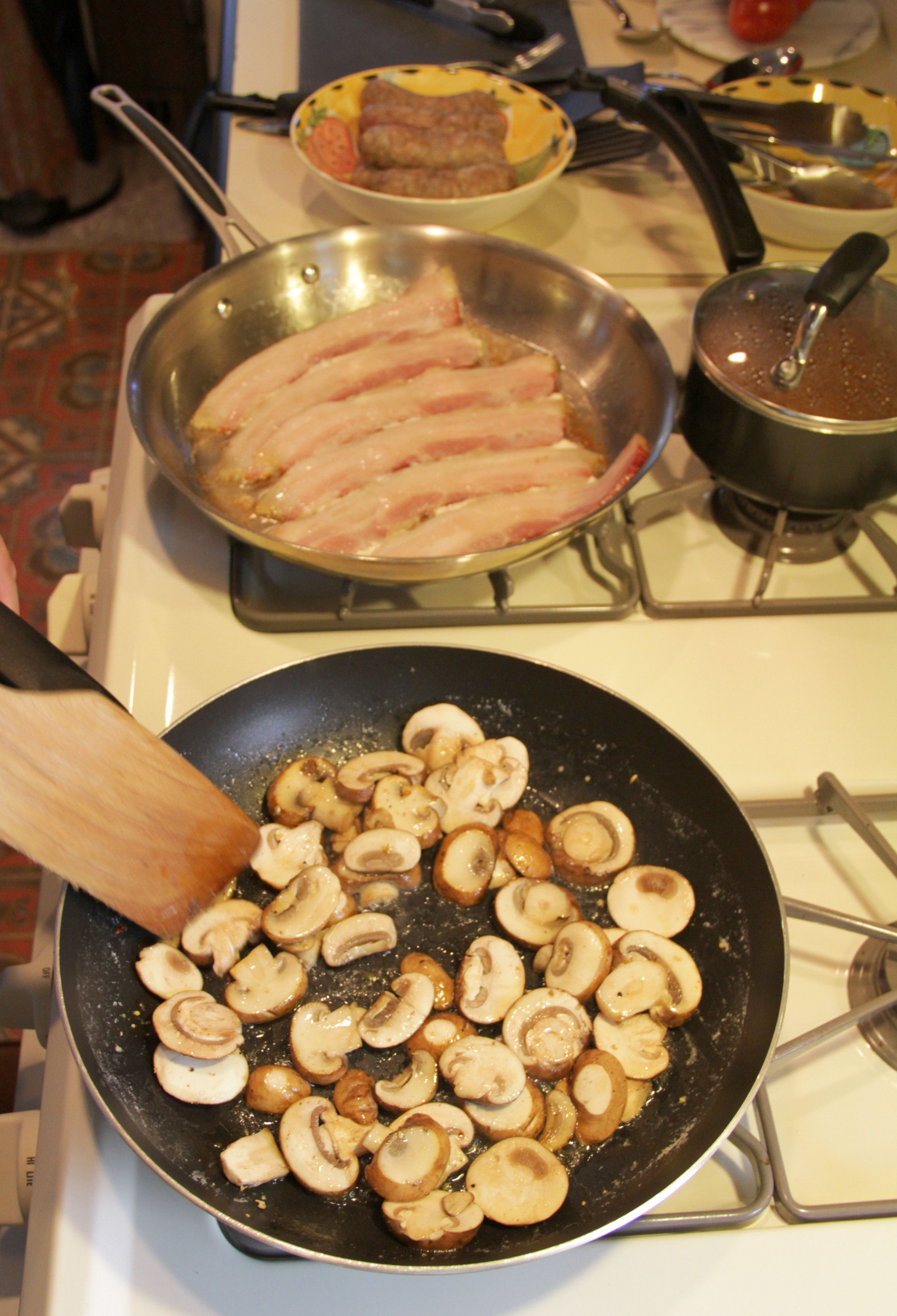Author Archives: charlesprogers
Breakfast in Bed: Jeff’s Proper English Fry-Up

Post by Alison Hein.
I coerced my good friends Rosie and Jeff to invite me for breakfast – a full English breakfast, that is. Although Jeff had never done a proper English fry-up before, he’s a talented, inventive cook who’s always up for a challenge. First, he located the nearest butchery where he could buy handmade, authentic bangers, the quintessential English sausages. (No way did the 150 mile round trip stop him!) Next, he studied up on English Breakfast history (a filling meal to tide one over through long working days), and painstakingly visited six stores before he found authentic HP Sauce, the traditional brown sauce used to spice up breakfast bangers and beans. (Originally made inBirminghamand named for the House of Parliament, it’s now made in theNetherlands, to the dismay of many Englishmen.)
Jeff spent more than one hour watching over his many steaming pots and pans with the grace and timing of an orchestra conductor. Then, while Rosie set a perfect harvest table and brewed a big pot of stout English Breakfast Tea, Jeff sautéed and spiced, poached and plated, fried up and finished a very proper, English breakfast in bed.

Here are Jeff’s tips if you want to try your own hand at a Proper English Fry-Up:
- Poach bangers in a slow water bath to keep them juicy and cook evenly. This may even help prevent banger explosion!
- Bring eggs to room temperature before cooking for a faster cooking time and a lighter, fluffier texture.
- Replace simple salt and pepper with a hardier seasoning, such as Trader Joe’s Everyday Seasoning, which contains salt, pepper, mustard, coriander, garlic, paprika and chili pepper.
- Black Pudding is optional!
Menu
Savory British Bangers
Vegetarian Baked Beans
Thick-Cut Slab Bacon
Buttered Mushroom Slices
Oven-Grilled Tomatoes
Griddled Toast
Black Lace Eggs

Ingredients
4 bangers
1 8-ounce can vegetarian beans (made inCanadapreferable)
2 tablespoons canola oil
4 slices thick-cut bacon
2 tablespoons butter
1 8-ounce package baby portabella mushrooms
Salt and pepper, to taste
Cooking spray
2 Roma tomatoes
2 slices soft, thick white bread
4 eggs
1 bottle HP Sauce (or other English Brown Sauce)

Preparation
Pour about 4 cups of water (enough to cover bangers) into a heavy pot and heat to 150º. Add bangers, and cook for about 20 minutes, using a thermometer to maintain temperature at a steady 150º. Remove bangers from water and set aside.
Add beans to heavy pot and warm over medium heat. Cover and keep warm until ready to serve.
Pour about 1 tablespoon canola oil into a heavy non-stick skillet and heat over medium heat. Add bacon and cook for about 18 to 20 minutes until browned and lightly crisp, turning once or twice. Remove from pan and place in oven to keep warm. Retain bacon grease, and reduce heat to medium low.
Add bangers to bacon grease and cook, low and slow, for 15 to 20 minutes, until well-browned. Remove bangers from pan and place in oven to keep warm. Remove pan from heat and maintain bacon / banger grease.
While bangers are cooking, add 1 tablespoon butter and remaining canola oil to a second heavy non-stick frying pan. When melted, add mushrooms, salt and pepper, and sauté for 5 to 7 minutes, until cooked through but still lightly firm. Remove from heat and place mushrooms in oven to keep warm.
While bangers and mushrooms are cooking, lightly spray a heavy, cast iron grill pan with cooking spray. Slice tomatoes in half and trim ends. Place on grill pan, and broil, approximately 4 inches from heat source, until tomatoes are cooked through and lightly blackened on top, about 8 to 10 minutes. Keep warm.
Reheat bacon / banger grease over medium-high heat. Add bread slices and cook until golden brown, turning once, about 3 minutes. Keep warm.
Add remaining 1 tablespoon butter and about 2 tablespoons of bacon / banger grease to a large, heavy frying pan. Heat over medium heat until bubbling. Break eggs into a small bowl, two at a time, then add to pan. Season with salt and pepper and cook, basting frequently with pan drippings, until whites are cooked through and yellow centers are still soft, about 2 to 3 minutes.
Place bangers, beans, bacon, mushrooms, tomatoes, toast and eggs on warmed plates and serve immediately.
Makes 2 Full English Breakfasts

Things We Like: The Power Nap

Post by Kyle St. Romain.
Many old world cultures have long held their afternoon naps commonly known as siestas (or pisolinos if you’re Italian) in great revere. The afternoon nap became prominent in warmer climates where midday heat affected work productivity. Many of these cultures also indulged in food-coma-inducing midday meals, which also helped set the stage for a nice siesta. Today, indoor air conditioning and artificial lighting may have eliminated the need for first world societies to sleep through the midday heat, but how many times do you wish you could grab a quick nap after lunch? I do.
Science is helping remove the stigma American culture has long associated with midday napping. No longer reserved exclusively for children and the elderly, napping has been linked to a number health benefits. One study, that tracked some 23,600 people in Greece over a six-year period, found that people who napped during the day were 37 percent less likely to die from heart disease, stroke, or cancer than those who didn’t. In other words, taking a planned nap (or a “power nap” as you may sell it to your boss) not only feels good, but also can help you live longer.
In addition to physical health benefits, napping can also help boost your cognitive functioning. Studies have shown that productivity, creativity, memory, alertness, and overall mood are all beneficiaries of an afternoon nap. In fact, a 2008 study showed that taking a planned nap is better than caffeine in improving verbal memory, motor skills, and perpetual learning. Naps are also better than caffeine when it comes to free recall memory. Coffee may be more efficient, but not as effective as a quick snooze.

If you’re looking to add a power nap into your schedule, there are some effective napping guidelines you should follow:
- The ideal nap is between 10 and 30 minutes in duration. Any longer, and you run the risk of turning your nap into a full-blown slumber. Ideally, you should awake from your nap feeling refreshed and energized — not groggy and sluggish.
- Aim to nap sometime between 1:00 and 4:00PM.
Keep in mind, however, that the above guidelines are not hard and fast rules. The ideal length and time to nap depends on your body’s needs. The ideal nap can range from 6 minutes to 90 minutes, so take some time to figure out what works best for you and your schedule.
The bottom line is that naps are good for us, and many companies are embracing this idea. Some of the biggest names in the tech industry, like Google, even offer sleep pods for their employees. So next time you’re fighting through the day, consider taking a power nap. And if your boss questions this behavior, let them know you’re only doing it for the company. 😉
Breakfast in Bed: Coconut Oatmeal

Post by Alison Hein.
Thick, steaming grains are an elemental part of my childhood memories – my mother would place a piping hot bowl of maple oatmeal on the table before me. Then, with precision, I would add a thick pat of butter to the center, allowing it to melt slightly before carefully strewing clumps of brown sugar on top. I would watch the sugar melt and spread to form a thin, sweet crust. Not quite done, I would carefully push the cereal gently toward the center of the bowl, and pour a scant ring of milk around the edges. Only then was it time to dig in, making sure never to stir, but to aim for that one perfect, prized bite of oatmeal, butter, sugar and milk.

I still enjoy hot cereal on a crisp fall or winter day, especially if I’m planning a brisk walk, mountain hike, or other outdoor adventure. Wanting to limit my butter / sugar intake, I experiment with varying flavors. Sometimes I’ll cook my oatmeal with diced apples, raisins and a touch of cinnamon. Other times, I’ll add unexpected twists, as in this recipe for Coconut Oatmeal.
Old-fashioned oats have a creamier texture than the quick-cooking variety, and only take a few extra minutes to cook. Cover the oatmeal and let it sit for a few minutes before serving, if you like, to allow the oaty flavor to percolate and the texture to soften. I keep it light with coconut water (now available at almost any grocery store) rather than coconut milk – significantly fewer calories, but still a light, infused tropical feeling. You can pour a touch of coconut milk on top, as I once did, for a breakfast in bed that will make memories.

Ingredients
¼ cup coconut flakes
1 cup coconut water
1 teaspoon vanilla
Dash of salt
½ cup rolled oats
Preparation
Preheat oven to 350°. Spread coconut flakes out onto a cookie sheet. Bake for 1 to 3 minutes, until they turn a light golden brown. Remove from oven and set aside.
Pour coconut water, vanilla and salt into a small heavy saucepan. Bring liquid to a boil. Stir in oats, and reduce heat to medium. Cook, stirring occasionally, until oats are soft and mixture is thickened, about 5 minutes. Spoon oatmeal into a bowl and top with toasted coconut. Serve hot.
Makes 1 serving.



 Post by Mark T. Locker.
Post by Mark T. Locker.